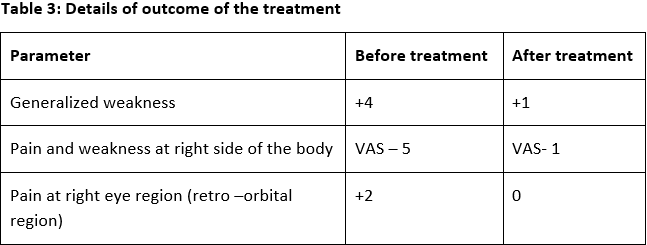Ayurveda management of Multiple Sclerosis - A Case Report
DOI:
https://doi.org/10.21760/jaims.10.9.60Keywords:
Basti Karma, Kaphavr̥ta Vyana Vata, Majja Kṣhaya, Multiple SclerosisAbstract
Multiple sclerosis is a chronic and progressive disorder that presents with various cognitive, motor, and sensory impairments. This autoimmune disease occurs when the immune system damages the myelin sheath surrounding nerve fibres, disrupting communication between the brain and the rest of the body. Although corticosteroids are commonly prescribed in conventional medicine, they often fail to provide comprehensive or sustained relief. In Ayurveda, while there is no explicit mention of multiple sclerosis, the condition can be classified under Vatavyadhi (~neurological and musculoskeletal disorders due to vitiation of Vata Doṣha) based on its clinical characteristics. A 54-year-old female homemaker presented with continuous, throbbing pain in the right temporal region, radiating to her neck, right upper back, and both upper and lower limbs for the past two years. She has a known history of multiple sclerosis, confirmed by MRI reports indicating chronic demyelinating lesions. In Ayurveda, she was diagnosed with Kaphavrita Vyana Vata. The treatment plan included Deepana Pachana with Anulomana, Basti Karma (~medicated enema), and Nasya Karma (~therapeutic nasal instillation of medicated oils), along with Shamana Chikitsa (~conservative therapy). Throughout her treatment, she was advised to follow Pathya-Apathya (~wholesome diet and lifestyle) to support the management of Vata Vyadhi. After three months of treatment, significant improvement was observed. The assessment of disease severity and quality of life using the FAMS scale, Berg Balance Scale, and SF-36 revealed significant improvements. This single case report demonstrates the effectiveness of Ayurvedic treatments for conditions similar to multiple sclerosis.
Downloads
References
1. Cree BAC, Hauser SL, editors. Chapter 192: Multiple sclerosis. In: Harrison’s Manual of Medicine. 20th ed. New York: McGraw Hill; 2020. p. 432–40.
2. Haslett CR, Chilvers ER, Boon NA, Colledge NR, Hunter JAA, editors. Multiple sclerosis. In: Davidson’s Principles and Practice of Medicine. 19th ed. Edinburgh: Churchill Livingstone; 2002. p. 1169–72.
3. Multiple Sclerosis International Federation. Atlas of MS 2020: Mapping Multiple Sclerosis Around the World. London: MSIF; 2020.
4. Shukla AV, Tripathi R, editors. Charak Samhita of Agnivesha, Chikitsa Sthana. Vol. II, Ch. 28, Ver. 228. Reprint ed. Delhi: Chaukhamba Sanskrita Pratishthan; 2017. p. 721.
5. Chidre S, Dhimdhime M, Dhimdhime S. Study of Majjadhatu in Madhumeha with special reference to diabetic neuropathy. Int Med Sci Acad Res [Internet]. 2019 [cited 2025 Jun 25]. Available from: https://imsear.searo.who.int/handle/123456789/202579
6. Ware JE Jr, Sherbourne CD. The MOS 36 Item Short Form Health Survey (SF-36). I. Conceptual framework and item selection. Med Care. 1992;30(6):473–83.
7. Berg KO, Wood-Dauphinee SL, Williams JI, Gayton D. Measuring balance in the elderly: preliminary development of an instrument. Physiother Can. 1989;41(6):304–11.
8. Cella DF, Dineen K, Arnason B, Reder A, Webster KA, Karabatsos G, et al. Validation of the Functional Assessment of Multiple Sclerosis quality of life instrument. Neurology. 1996;47(1):129–39.
9. Shukla AV, Tripathi R, editors. Charak Samhita of Agnivesha, Siddhi Sthana. Vol. II, Ch. 28, Ver. 58–60. Reprint ed. Delhi: Chaukhamba Sanskrita Pratishthan; 2017. p. 699.
10. Shukla AV, Tripathi R, editors. Charak Samhita of Agnivesha, Siddhi Sthana. Vol. II, Ch. 15, Ver. 96–97. Reprint ed. Delhi: Chaukhamba Sanskrita Pratishthan; 2017. p. 374.
11. Misra SB, Vaisya RR, editors. Bhavprakasa Nighantu of Sribhav Misra. Vol. II, Ch. 1 (Haritkyadivarga), Ver. 53–58. Varanasi: Chaukhamba Sanskrita Bhawan; 2020. p. 208.
12. Shukla AV, Tripathi R, editors. Charak Samhita of Agnivesha, Siddhi Sthana. Vol. II, Ch. 12, Ver. 15–16. Reprint ed. Delhi: Chaukhamba Sanskrita Pratishthan; 2017. p. 981.
13. Vyas SD, et al. Nasya Karma Karmukatva – A review article. Int Ayurvedic Med J. 2020;8(5):3549–52.
14. Bramhanand D, editor. Sarangadhara Samhita of Pandit Sarangadharacharya. Madhyama Khand, Ch. 7, Ver. 28–31. Varanasi: Chaukhamba Sanskrita Bhawan; 2020. p. 93.
15. Bramhanand D, editor. Sarangadhara Samhita of Pandit Sarangadharacharya. Madhyama Khand, Ch. 7 (Vataka Kalpana), Ver. 56–69. Varanasi: Chaukhamba Sanskrita Bhawan; 2020. p. 135.
16. Kuboyama T, Tohda C, Komatsu K. Effects of Ashwagandha (roots of Withania somnifera) on neurodegenerative diseases. Biol Pharm Bull. 2014;37(6):892–7.
17. Sutradhar RK, Rahman AKM, Ahmad M, et al. Bioactive alkaloid from Sida cordifolia Linn. with analgesic and anti-inflammatory activities. Iran J Pharmacol Ther. 2006;5:175–8.
18. Misra SB, Vaisya RL, editors. Bhavprakasa Nighantu of Sribhav Misra, Haritakyadi Varga. Vol. II, Ch. 1, Ver. 64–65. Reprint ed. Varanasi: Chaukhamba Sanskrita Bhawan; 2020. p. 310.
19. Roshanbakhsh H, Salmani ME, Dehghan S, Nazari A, Javan M, Pourabdolhossein F. Piperine ameliorated memory impairment and myelin damage in lysolecithin-induced hippocampal demyelination. Life Sci. 2020;253:117671.
20. Shastri VL, editor. Yogratnakara Vidhyotini Hindi Teeka, Vatavyadhi Chikitsa. Reprint ed. Varanasi: Chaukhamba Sanskrita Bhawan; 2022. p. 468–9.

Published
How to Cite
Issue
Section
License
Copyright (c) 2025 Manisha Chaudhary, Mandip Goyal, Charmi Mehta

This work is licensed under a Creative Commons Attribution 4.0 International License.














